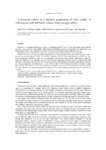Mostrar o rexistro simple do ítem
Laboratory values in a spanish population of older adults: a comparison with reference values from younger adults
| dc.contributor.author | Millán-Calenti, José Carlos | |
| dc.contributor.author | Sánchez, Alba | |
| dc.contributor.author | Lorenzo-López, Laura | |
| dc.contributor.author | Maseda, Ana | |
| dc.date.accessioned | 2015-03-16T11:00:50Z | |
| dc.date.available | 2015-03-16T11:00:50Z | |
| dc.date.issued | 2012-01-30 | |
| dc.identifier.citation | Millán-Calenti JC, Sánchez A, Lorenzo-López L, Maseda A. Laboratory values in a spanish population of older adults: a comparison with reference values from younger adults. Maturitas. 2012;71:396-401. | es_ES |
| dc.identifier.uri | http://hdl.handle.net/2183/14256 | |
| dc.description.abstract | [Abstract] Objective: To examine the laboratory indices in a population aged 65 years or more and compare them with the reference values used for young adults. Study design: Distribution patterns of frequently used biochemical and hematological indices were examined in a sample (N= 600) of non-institutionalized adults aged over 65. Outcome measures: The obtained values were compared with the reference intervals for young adults. Results: On some of the indices analyzed, large proportions of the participants had values above the upper limit of the reference interval: glucose, 25.0%; urea, 26.6%; creatinine, 27.2% of males; total cholesterol, 54.6%; and low-density lipoprotein cholesterol, 35.8%. Of the participants who met the World Health Organization’s diagnostic criteria for diabetes, 31.8% said they had not been previously diagnosed. Similarly, 74.9% of subjects with total cholesterol values above the reference value indicated in the European guidelines on cardiovascular disease said they had not been diagnosed with dyslipidemia, as did 75.5% of those with low-density lipoprotein cholesterol values above the European reference value. The proportion of participants who were not aware that they might be suffering from those disorders was significantly higher among those who reported not having visited their doctor within the last 6 months. Conclusion: Further studies should examine whether the use of adapted, more appropriate reference values for elderly populations will help physicians to make early and correct diagnoses and to decide when medical intervention is required. | es_ES |
| dc.language.iso | eng | es_ES |
| dc.publisher | Elsevier | es_ES |
| dc.relation.uri | http://dx.doi.org/10.1016/j.maturitas.2012.01.005 | es_ES |
| dc.subject | Clinical chemistry variables | es_ES |
| dc.subject | Reference values | es_ES |
| dc.subject | Elderly | es_ES |
| dc.title | Laboratory values in a spanish population of older adults: a comparison with reference values from younger adults | es_ES |
| dc.type | info:eu-repo/semantics/article | es_ES |
| dc.rights.access | info:eu-repo/semantics/openAccess | es_ES |
Ficheiros no ítem
Este ítem aparece na(s) seguinte(s) colección(s)
-
GI-GIGG - Artigos [111]






